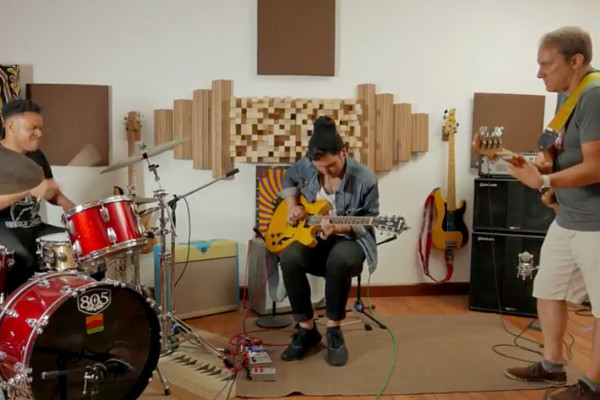Soul Fish: An Interview with Carey Nordstrand
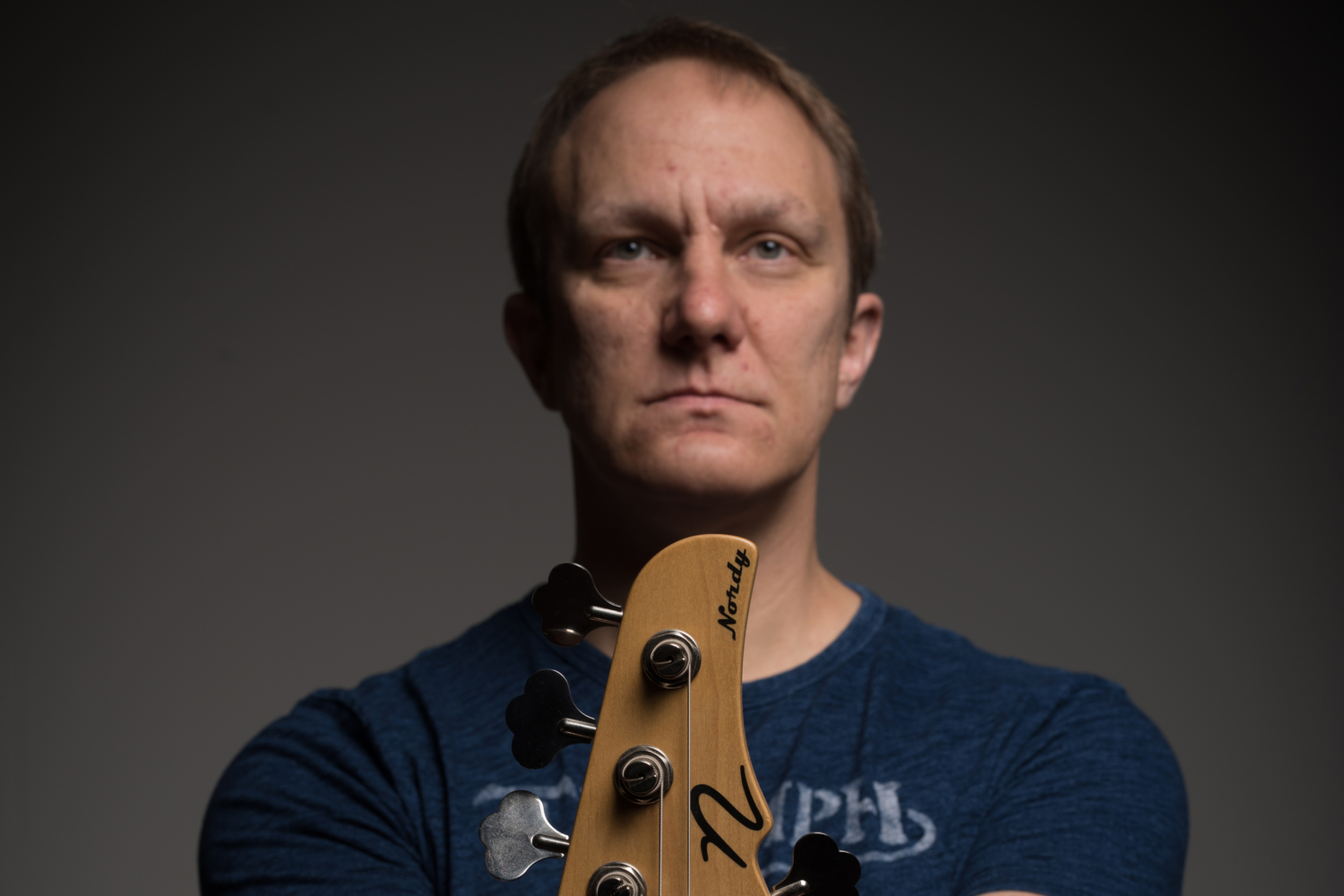
As an instrument builder and pickup maker, Carey Nordstrand has helped scores of musicians find their voice in their tone. Now he’s getting to share his own musical voice with a new release by his band, Moba Jones.
Soul Fish is the culmination of musical experiences of Nordstrand and his musical compatriot Edward Heppenstall, whose influences range from Peter Gabriel to Sade to Tool. That might sound overly broad, they admit, but the mix of styles blend into a seamless synthesis of their tastes. And while Nordstrand has worked with the world’s top players, his bass lines are unique to his own senses: supportive, yet memorable.
We caught up with Nordstrand to get the scoop on Soul Fish, his writing process, and how he likes to get creative.
Last time we talked, you were working on putting your studio together.
I put this room together with a special floor and gave it special treatments and everything. I posted pictures of it here and there, but this summer will be three years since I put that together. It just completely changed my creative life. Having a dedicated space made a huge difference.
You feel like you can just get in there and shut out the rest of the world?
Absolutely. You can really get into that creative flow and explore to see where it goes. Having that space, there’s no better way for me to test stuff or come up with ideas about what I want to make next or to really get inside what makes an instrument or pickup. I feel like I’m immersing myself in all this stuff that makes up tone, and that space has been really important for that. I’ll finish something up in the shop and I grab it and run over to the studio. I’ll pull up a beat and just come up with something.
We did this Seratone fuzz pedal, and just plugging straight into my Apollo got me some great sounds. Then Ed will come over and I’ll show him something that will spark his creativity and he’ll say, “Put up a mic, I have an idea!” Then we can just go. So yeah, that space has been central to the way things have gone here over the last few years.
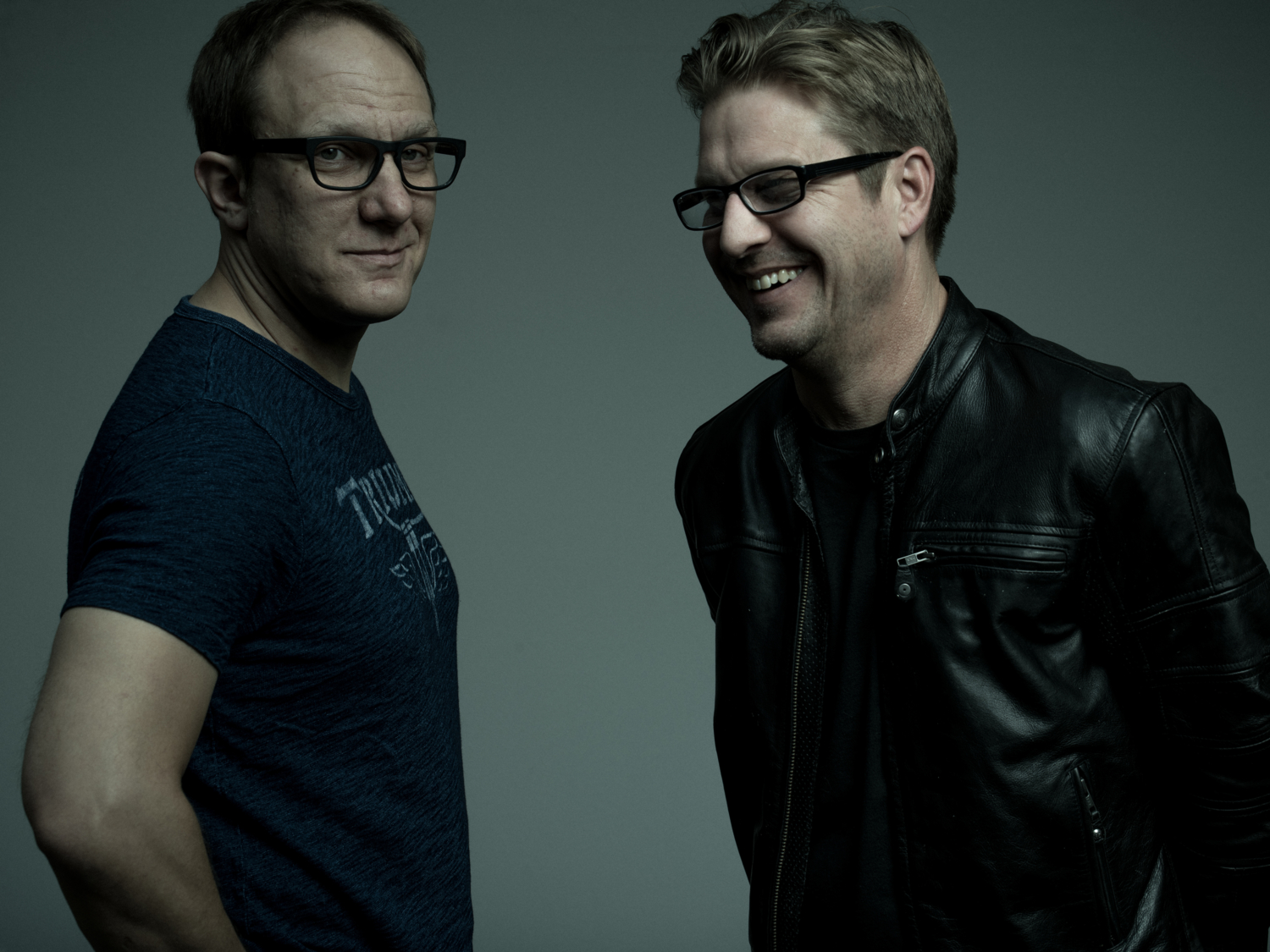
From reading the Moba Jones website, it seems like Ed was your bass teacher back in the day. Is that right?
Yeah, he was. I started on saxophone in fourth grade. I went to UC Riverside and was in a jazz ensemble there. I got to the point where I could sight-read crazy good because I’d never practice. You learn to sight-read really fast that way. [laughs] The guy that was running the jazz ensemble there kicked all of the saxophones out of the band because he was doing a CD in his basement studio. He brought in a bunch of ringers apparently. All of the sax guys were like, “What the hell? Can he do that?” Either way, he did. At that point I was looking at this really nice intermediate alto sax that I had and I thought, “Eh, I’m kind of over this.” Right around the same time, my parents were going to see Kenny G, who was a big deal back then. This would have been about 1992. They took me along and I saw Vail Johnson come down and do this pyrotechnic solo. My jaw hit the floor. Literally within a couple of weeks I was trading my sax in for a bass.
I got this crazy Washburn Bantam bass that was black with orange binding on it. I decided I needed lessons, so I went to the local guitar shop and Ed was teaching lessons. He had gone to MI for a bit, so to fill in the gaps economically he was teaching. I started taking lessons with him and we just kept in touch ever since then. I moved away and did my guitar career. I worked for Steve Azola for two years and John Suhr for four years, then I moved back up here locally. We started hanging out some more.
Really, the evolution of recording technology also made this whole thing possible. As soon as those Universal Audio Apollo units came out where you could plug right into them and still sound good as well as get a killer reverb without any latency, that was instrumental for me. Normally you’d have to set up an amp and all this gear that cost a lot of money, so that was liberating to have that instant access to inspiring sounds. I use this program called BFD 3 on the album, except for the first track, which has a real drummer. But when you get inspired and can pull up a drum beat real quick, that’s how it flows best for me.
Ed and I started hanging out more and at some point, it turned into this thing, where we said, “Wow, I guess we’re doing an album.”
So it was pretty organic how this all came together.
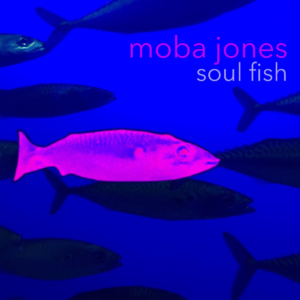 Well, it’s just the two of us except for a couple of outside people we brought in for random things. What we used to do was get together and pull out our iPods to try to play a song that would blow the other guy’s mind. We’d sit there and go back and forth for hours, just getting inspired by music. So I knew we had this chemistry. We’re kind of on the same page for our musical tastes. The cool thing is we’re not too close but we’re not too far apart, so we overlap in a really cool way that makes us create music we wouldn’t have made on our own.
Well, it’s just the two of us except for a couple of outside people we brought in for random things. What we used to do was get together and pull out our iPods to try to play a song that would blow the other guy’s mind. We’d sit there and go back and forth for hours, just getting inspired by music. So I knew we had this chemistry. We’re kind of on the same page for our musical tastes. The cool thing is we’re not too close but we’re not too far apart, so we overlap in a really cool way that makes us create music we wouldn’t have made on our own.
I went to school for recording before my music career, actually. So my first love really was that I wanted to be involved in music from an engineering standpoint, but then this guitar career thing happened. I had a knack for woodworking and all of that stuff.
It seems like you find what you love doing, and then you attack the technical aspect of it.
That’s exactly it – if by technical aspect you mean dive in and learn as much as I can and completely immerse myself in understanding what I want to be doing. Yeah, that’s my approach. When the internet first became a thing, I was at Steve Azola’s place when I got my first computer. You could go on websites and look at pictures. I’d look at all these guitar builders and luthiers. There was this killer website called Frets.com. It’s still out there, and it just had tons of great material on there. He’d go out and tour people’s shops and write pieces. As soon as I learned I could just consume information, it was just life-changing. Then I learned how to do guitars, photography, and then pickups. That’s applied in the musical realm, too.
On this album, I played the bass, I played guitar, I programmed the drums, and I did a little backup singing. Ed did a couple guitar parts and the singing. It’s all just done by us two, except for the tune “I Can’t Wait”. We got James Raymond, who is out on tour with David Crosby, to do keys and horns, which just blew that song up huge. It was fun to do that. We had a friend play drums on “Taken Down”, then Julia Lenhardt sang on “Hands are Down”. That song was sounding really cliche and we couldn’t figure out what to do with it. We gave it to her and pulled all the vocals off and she came back to us with this killer chorus and a couple of verses.
That song gets a little heavy.
Yeah, there’s a part in there. It kind of alternates between this mellow part and a really heavy break section. Then it’s vocals again and the bass does this cool little line.
You’ve been in this industry for some time now and you have some of the best musicians around coming through your shop. How much of that has rubbed off on you? I think it puts you in a pretty unique situation.
I’m extraordinarily lucky and things have gone in a manner that I couldn’t even have dreamed. To be able to know the players that I know and to call a lot of them friends… When you’re involved in helping someone sort out their tone, you really have to pay a lot of attention to what they do: how they play, what they’re into, how their hands work. All that stuff is part of what is going to come out of the speaker at the end of the chain. I have absolutely internalized a lot of that, not so much in terms of note choice or harmonic intent. I think a lot of my sensibilities in that regard come from my early experiences in music and influences. I talk about everyone from Peter Gabriel to Led Zeppelin to the Bee Gees. It’s a really broad range of stuff I got into in my early teens up until my early 30s. In terms of tone and sound technique, being exposed to all of these players [is incredible.] Watching someone pickup a P-bass and go for a specific type of tone and then grab a J-bass and go for something completely different and so on. I’ve been extremely lucky to be exposed to so many approaches and sounds. Most of the time when I work with someone new and we sit down, they show me what they’re doing and I’m like, “Oh that’s cool. I’m going to put that in my player rolodex and maybe pull it out sometime in the future somehow.” But none of the music was consciously [imitative]. It wasn’t like, “I want to sound like early Pino fretless here” or “This is a Mick Karn slide.” It was really like trying to turn off the thinking mind and play what makes sense to me emotionally and foundationally.
To an extent, that’s all we are anyways, right? We’re taking our influences and synthesizing them into what becomes “us”.
Hopefully, yeah. Hopefully, we reach a point where we move beyond sounding like somebody and we start sounding like ourself. I hope that’s how this project is perceived.
I think it does. It sounds like you. Obviously, you’ve listened to the greats and all the talented players you have coming through. Even being in the business forces you to be open to more playing styles and genres and ideas. I think the bass playing on the album overall is very foundational, yet melodic.
A couple of the bass lines I came up with ended up being very hook-y. I just end up singing the bass line in certain sections of the songs instead of the melodies, especially on that song “Hands Are Down”. When that came out of me, it was like “Woah.” But that’s very flattering. I’m delighted you heard it that way because that’s what I’m really about.
Another unique position for you is that you can create just about any tone you like with your instruments. How much of the sounds on the album did you have in your head and how much were you inspired by a bass you already had?
It would go either way. It would be dependent on where the song started. Sometimes the bass line would start a tune. I’d pull up a drum beat and I’d hear a bass line groove. I’d play it and then the song would grow from there. The sound of the bass in that particular case was the foundation for what was built on top of it. Sometimes I’d start a song with a drum beat or guitar riff, then I’d pick a bass and it wouldn’t really fit. I’d hunt a little bit to find just what I wanted to fit the track.
The assemblage of instruments that I have around have a very specific set of sounds. All of these instruments are here because they’re sounds that I hear in where my music wants to go. The fretless on the first track, “Taken Down”, has a BigMan pickup in it. I did that because I had another bass I finished that had a BigMan pickup in it, and I wanted that punchy, growly sound from that bass but I wanted it on a fretless. It’s fat and supportive, yet still a really interesting fretless sound. So they kind of lead me into each other sometimes. Then sometimes I get to where I think, “Ok, well I’m going to have to build a bass for this sound.”
I’ve done that a few times. The VJ5 Slim with the BigMan and the soap bar in the neck position was built specifically so I could have that sound. I built that copper bass as well. I built it for a band that I was in briefly and it worked great for that. The basses come and go, but there are a few that I’ll never get rid of. The P-bass on “Hands Are Down” is my butterscotch P5 that I had Pino Palladino sign. I have an NJ-5 that I built for myself in 2004 that I end up using to test pickups. Funny enough, I’m building a clone of it for Chris Tarry. He played that bass at NAMM probably nine years ago and last year he said, “Do you still have that bass?” I said yes, but I’m not selling it so I’m building one for him.
You’re not building a lot of basses anymore though, is that right?
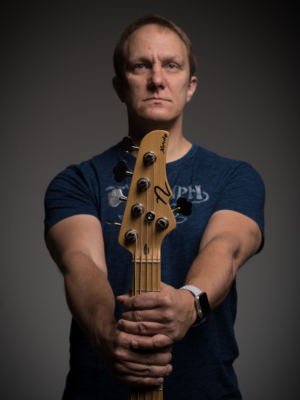 I stopped taking orders. Just the other day I told somebody after they listened to the record that this is why I stopped. I need more time to do this creative stuff. [laughs] We’re doing a lot of stuff in the shop here, too. It’s not just the music. We’re launching Rocket Surgeon Pedals, we have a new website, and we’re kind of rebranding everything over to Nordstrand Audio. That way we can do more interesting stuff and not have it pigeonholed into just pickups. I’ve got a new hum-canceling Strat system that we’re trying to get a patent on, too. It’s a unique way of doing things, so we’re excited about it. I also got a 3D printer so we can quickly make prototypes and test.
I stopped taking orders. Just the other day I told somebody after they listened to the record that this is why I stopped. I need more time to do this creative stuff. [laughs] We’re doing a lot of stuff in the shop here, too. It’s not just the music. We’re launching Rocket Surgeon Pedals, we have a new website, and we’re kind of rebranding everything over to Nordstrand Audio. That way we can do more interesting stuff and not have it pigeonholed into just pickups. I’ve got a new hum-canceling Strat system that we’re trying to get a patent on, too. It’s a unique way of doing things, so we’re excited about it. I also got a 3D printer so we can quickly make prototypes and test.
What is the story behind the album title and the title track?
That track and “Disappear” are kind of the emotional center of the album. I had some bits and pieces for a song and Ed came around. We put a mic up and he just started singing “soul fish” just out of nowhere. He didn’t premeditate it at all; it just came out of him. We were like, “What is a soul fish?” And who knows? It could be whatever you want it to be, really. That tune is really about nothing in particular, but the spoken stuff in the background is this guy Jiddu Krishnamurti. He was a spiritual philosopher. He was from India, and he had this book “Total Freedom” about how humans are conditioned and that conditioning creates a false reality. In other words, how we perceive the world is how we live in the world and we get in our own way all the time with our attachments to things. If we can truly understand how our mind works by investigating things on our own through meditation or various forms of self work that are available to us, that’s the only way we can be truly free. It’s enlightenment and self-realization. That particular audio came from a discussion he did with a physicist named David Bohm. They would video these discussions that were inquiring into the nature of the mind. So this physicist and philosopher would go back and forth exploring this. I pulled the clip off of YouTube and piped it into the recording system. We ended up taking Bohm’s part out of it because it didn’t work in the way that just Krishnamurti’s voice did. It was funny because we hit record and had the song mostly there. Then the very end where he says “state of his being” just lined up perfectly like that. Ed and I looked at each other and said, “Oh my god!” So that’s what that spoken part is. I just really like that, “what’s going on in the background” thing. It adds curiosity.
To tie it all up, I’m hoping that this album and this material resonates with bass players. Ed and I are middle-aged. We have no delusions about being rock stars or anything like that. We’re doing this because we love to do it and it’s who we are. We feel very fortunate that we get to do this and squeeze it into our day-to-day jobs. We put a lot of love and energy into this and we appreciate people putting it into their ears.
Soul Fish is available now on Bandcamp and will be available on all major platforms June 23rd.

